Schiit Audio Freya + Tube Preamplifier by Paul Szabady
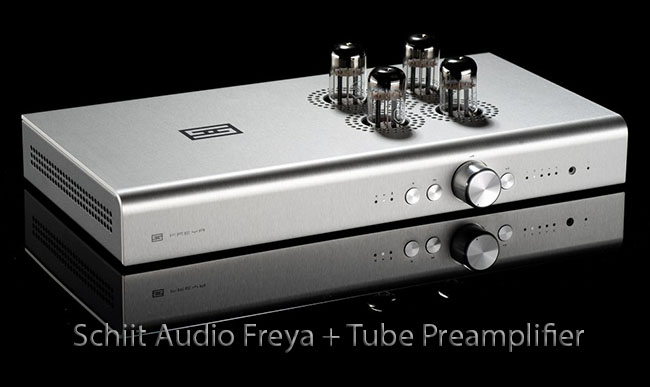
I’ve always been on the look-out for audio gear that produces seriously high fidelity at a price that the average-incomed music lover might actually afford. Since it’s now possible to spend over $1,000,000 on a High-End system, the pricing of the Extreme High End makes it impossible to avoid the word ‘decadent’ in talking about it.
It’s no secret that the vast majority of serious Audiophiles are middle-aged and older men, upper-middle-class perhaps, but with comfortable rather than outrageously high incomes. The extreme ‘carriage trade’ (aka “Rip-off the Rich Twits”) pricing of too much of the High End stretches the finances and drops the jaws of even these dedicated listeners.
Most distressing is the Pavlovian Conditioning rampant in the Audiophile market that automatically assumes that higher price always equates to higher performance and that extreme pricing always means extreme quality. The fact that the market pressures designers to raise their products’ price to be taken seriously artificially – is deeply disturbing.
 One can only imagine the effect of that stratospheric pricing on the next generations of potential Audiophiles, most of whose experience of music has been through headphones and sourced from streaming digital files on their computers and cell phones. Can one imagine any of them spending $1,000,000 on an audio system? Can one imagine any of them even spending $10,000? Though founded and run by principals from High-End firms (Theta and Sumo), Schiit Audio established itself catering to that younger market, offering very high-quality but very affordable DACs, headphone amps, and other products for those generations who grew up wholly immersed in Computer World. California-built and sold Internet-direct, Schiit has been moving toward more traditional audio products, including an integrated amplifier, two power amps, a phono stage, and even their first foray into producing a turntable – the $800 Uni-pivot armed Sol.
One can only imagine the effect of that stratospheric pricing on the next generations of potential Audiophiles, most of whose experience of music has been through headphones and sourced from streaming digital files on their computers and cell phones. Can one imagine any of them spending $1,000,000 on an audio system? Can one imagine any of them even spending $10,000? Though founded and run by principals from High-End firms (Theta and Sumo), Schiit Audio established itself catering to that younger market, offering very high-quality but very affordable DACs, headphone amps, and other products for those generations who grew up wholly immersed in Computer World. California-built and sold Internet-direct, Schiit has been moving toward more traditional audio products, including an integrated amplifier, two power amps, a phono stage, and even their first foray into producing a turntable – the $800 Uni-pivot armed Sol.
Schiit’s Aegir Class A power amplifier (reviewed here) impressed me mightily and continues to impress me with continued use. Mated to reasonably sensitive loudspeakers played at reasonable volume levels, the $799 Aegir brings a level of refined sonic purity and musical communication completely unheard of in its price class. Class A for the Masses assuredly, and yes, good enough to build a system around. Schiit Audio produces various US-built’ preamps’ to run the Aegir, starting at $49 for their SYS passive 2-input volume-pot controlled switch box. The Saga+ at $399 offers a sophisticated remote-controlled relay-switched stepped-attenuator volume control, with 128 steps of 0.625 dB, along with passive operation or a single 6SN7 tube buffered output.
Finally, the $899 Freya +, reviewed here, includes the same volume/input control and straight passive operation, plus a choice of a FET buffered passive output or active tube amplification (12 dB of gain from four 6SN7 tubes.) When run in passive or buffer mode, the Freya+ shuts off the tube stage to save power usage and extend tube life. The Freya+ can be used in single-ended or balanced output mode and also offers single-ended to balanced conversion inactive tube and in buffer operation. Inputs include two Balanced and three Single-Ended pairs; outputs are one balanced and two single-ended pairs.
The Freya+ is an ultra-wide bandwidth design performing at distortion and noise levels usually only associated with top solid-state gear. It’s hard to imagine an existing system (or future system) with which the Freya+ would not mate. Its flexibility is unique at any price. I treated the Freya+ as an active tube preamplifier driving the Aegir power amp (among six others, both tube and solid-state) through conventional RCA to RCA interconnects for most of my auditions. The exception was Graham Slee’s Proprius amplifier, which allowed fully balanced XLR running. The tube preamp/solid-state power amp strategy to get the magic of tubes and the bass response/control of SS power has long been a very cost-effective method to maximize performance. Since the performance of any individual component in an audio system depends ultimately on the quality of the component immediately preceding it in the audio chain, using a tube preamp to drive a solid-state power amp is one way to add the much-desired qualities of tube sonics without also having to use a tube amplifier.
Tube purists might object and consider using a solid-state amp as a compromise, but the fact remains that truly top-notch tube amplifiers aren’t exactly cheap, and ones with indeed excellent bass control are rare. Using a solid-state power amplifier also expands one’s choice of loudspeakers, as the vast majority of available contemporary loudspeakers are of average to low sensitivity, use bass-reflex woofer-loading that assumes high damping factor and low output impedance from its driving amplifier, and possess impedance curve dips and phase angles in the bass regions that are very current-hungry. Not exactly what tube amplifiers excel at. There’s nothing worse than owning a loudspeaker that you don’t really like merely because it works well with tube amps.
 Physically, the Freya+ partakes of the spartan, matte aluminum-clad house appearance of most of Schiit Audio’s products. Weighing in at a very solid-feeling 11 lbs., the Freya+ measures 16 inches wide by 6 inches deep and 2 inches high. It’s basically a slab with four tubes sticking out the top on its right-hand side, adding another 2.5 inches to its height.
Physically, the Freya+ partakes of the spartan, matte aluminum-clad house appearance of most of Schiit Audio’s products. Weighing in at a very solid-feeling 11 lbs., the Freya+ measures 16 inches wide by 6 inches deep and 2 inches high. It’s basically a slab with four tubes sticking out the top on its right-hand side, adding another 2.5 inches to its height.
Cosmetics are the least important factor in assaying audio components: audio gear, for me, is simply a tool whose purpose is to release the art of music. I don’t look at audio gear; I listen to it. The Freya+’s austere appearance dimly echoes the abstract aesthetic of the Bauhaus School of Design and is much in keeping with Schiit’s goal of keeping costs down and avoiding pointless High-End pretense and extravagance.
Ergonomics, however, is a different matter. Schiit places the on/off switch on the Freya’s back (ditto for the Aegir,) demanding that one keep one’s wits about oneself when switching the unit off, as the exposed tubes get hot and also heat up the top of the Freya+’s case. Fortunately, particularly for left-handed people, the power switch is on the left side as one faces the Freya+, precluding having to reach over the hot tubes. Front panel controls are dimly labeled in a code I could never break, or even comfortably see, thus requiring memorization of their logic and function or constant reference to the owner’s manual. They’re also sized to be compatible with the visual acuity of hawks, eagles, or human beings equipped with binoculars or magnifying glasses.
The ‘improved’ remote-control, apparently heavier and more deluxe than its predecessor, continues the eye-strain of the Freya+’s front panel and is heavily biased against adults with normal-sized fingers. It is quick-on-the-trigger with volume changes (while also producing audible clicks), making minimal incremental changes difficult, at least until one gets used to it. Fortunately, one can just use the panel volume control manually. The remote control ‘remembers’ manual changes.
The Freya+ is shipped without its tubes installed. Since its tube sockets are recessed below cut-outs in the top of its case, installing the supplied 4 JJ-sourced 6SN7 tubes is done partially blind and guaranteed to scare tube newbies, and even damping confidence in one like me, with over 30 years of tube usage. Schiit Audio has a reputation for being idiosyncratic and maverick, if not actively eccentric. While the Freya+’s ergonomics are not idiot-friendly, it only took this idiot a couple of days to acclimate to its demands. It was well worth the effort, as the sound quality and musical communication of the Freya+ completely transcended any quirks experienced in set-up and operation. I auditioned the Freya+ in three different systems, in three other rooms, with various power amps, both solid-state and vacuum-tubed, and with four different loudspeakers. The Freya+ came into song easily and relatively quickly, not requiring tedious extensive burn-in or warm-up. Ten hours of initial usage, and Freya+ was already strutting its stuff. I waited until 50 hours of use before beginning critical listening. I did not subject the Freya+ to any excessive tweaking, relying instead on reviewing it as an intended buyer would likely experience it. I used the supplied power cord, budget interconnects at less than $200 per pair (including ones at only $20/pair,) and refrained from swapping in other 6SN7 tubes.
But, since the rest of the three systems I used were all isolated with state-of-the-art Stillpointstm Isolators, speakers included, I listened to the Freya+ on a set of 3 original Stillpoints each system. My comments, however, are based on the Freya+ played ‘neat,’ without any isolation. If you really want to hear everything that the Freya+ is capable of, a set of Stillpoints Ultra Minis is a must audition. I would do this before trying exotic and expensive interconnects, power cords, or collectible NOS vacuum tubes. The gains in performance are far greater and give a more reliable gauge to any other changes. State-of-the-art isolation is the ultimate foundation and determiner of performance of any component and total system: a fact I’ve experienced consistently over the last 28 years. One of the design applications of the Freya+ is to allow running of 2 Aegirs as mono-block 80 watts/channel Class A amplifiers (in balanced mode only.) I was unable to evaluate that application, having only a single Aegir on hand.
 My first cursory assays (in 3 different systems, one driving Schiit’s Aegir amp through budget Monitor Audio Bronze 5 speakers, the second in my’ Reference’ system driving the wide-bandwidth, monster transformer-ed EICO HF89 tube amp playing the Sound Lab Dynastat speakers) evoked continuous exclamations of the sacrality of excrement, vocal ejaculations recognizing the immanence of a personal High Divinity, and exhortation of the name of the 2nd person in the Christian Holy Trinity, complete with a middle initial. The result was hurricane-velocity extinguishing of mundane consciousness and the repeated voicing of the 3-letter word indicating awe.
My first cursory assays (in 3 different systems, one driving Schiit’s Aegir amp through budget Monitor Audio Bronze 5 speakers, the second in my’ Reference’ system driving the wide-bandwidth, monster transformer-ed EICO HF89 tube amp playing the Sound Lab Dynastat speakers) evoked continuous exclamations of the sacrality of excrement, vocal ejaculations recognizing the immanence of a personal High Divinity, and exhortation of the name of the 2nd person in the Christian Holy Trinity, complete with a middle initial. The result was hurricane-velocity extinguishing of mundane consciousness and the repeated voicing of the 3-letter word indicating awe.
It also had me re-checking the Freya+’s $899 price: surely some far larger number was omitted in front of the 8? Like a 2 or 3 or a 4?
Long-time tube fanciers know that there is more to tube amplification than simply placing rose-colored glasses onto the audio proceedings. Tube gear’s ineffable way of accurately reproducing the natural timbre of instruments instead points to a higher fidelity. Even anti-tube antagonists will admit that tube amplification of midrange frequencies produces a uniquely vivid, natural, and harmonically-complete depiction of that frequency range, along with unmatched depiction of the acoustic in which the sound is generated. Since at least 80% of music is in the midrange, the tube’s superiority in that region is more than enough for many listeners to embrace technology completely. But what about the other 20% – the bass and high frequencies? While some vintage tube components might be criticized for loose bass and somewhat soft highs, there were others available even in the 1960’s vintage days that did not compromise. (Hint: check out Stewart Hegeman’s wide-bandwidth designs for EICO, Lafayette, and Harman/Kardon.) Properly designed, modern tube gear is fully capable of a full 10-octave range.
The Freya+ is certainly a modern tube preamp design: it covers the entire musical range with transparency, clarity, and ultra-resolution that is impossible to criticize. Gone are the tube bugaboos of hiss and noise, along with any imputation of added euphonic distortion. What the Freya+ offers is a superb, true-to-life reproduction of the sound of each instrument. Stringed instruments, for example – the guitar, the violin, cello, and double bass, among the others – are depicted intact, capturing both string tone and its exact harmonic structure, along with the woody resonance of each instrument’s body. The Freya+ excels at accurately and naturally reproducing the timbre of each instrument in a recording, revealing the ineffable beauty that is inherent to musical instruments. It was an immensely sensually gratifying experience to just listen to the sound of instruments.
Even more importantly, the Freya+ does this with all the instruments in a recording, allowing the listener to hear each instrument clearly and completely and to follow its contribution to the whole of the music in volume, dynamics, timing, and rhythm. Musically significant particularly is the Freya+’s aptitude with low-level detail, subtlety, and nuance. It effortlessly reveals not only What is being played but exactly How it is being played. The classic, now almost cliche, tube forte of solo female vocal with sparse acoustic instrument backing was a deep joy to experience. I used Aretha Franklin, Roberta Flack, Jacqui McShee (of Pentangle,) and Sandy Denny (Fairport Convention and solo) to test for this. The Freya+ strongly underlined exactly why I’m so moved by these vocalists. It was the same for some of my favorite male vocalists – Joe Cocker, Steve Winwood, Nick Drake, and Neil Young. The Freya+ produced a definite gain in image height when used with conventional dynamic-coil speakers, an effect that my reference Sound Lab Dynastats with their line-source 6-foot-tall electrostatic panels excels at. The result was again in scale and image size that was far more natural and convincing.
The Freya+ displayed all the wonderful sound-staging details that are the hallmark of tube electronics. Nailing the width, height, and depth of the soundstage was just the beginning: the Freya+ excelled at producing the ambiance of the acoustic in which instruments play. Exceptional also was its ability to reproduce the ‘bloom’ of an instrument: the enlarging of the ambient field and space. The instrument gets louder and projects its sound further into a larger space. I was floored by this achievement, as the ability is extremely rare. Communication of music’s intent is first-rate, artistic distortion among the lowest I’ve ever heard, regardless of price. I can’t begin to enumerate how many times I experienced chills down my spine and the deeply satisfied euphoria that great art should induce. The Freya+ produced this effect with all music genres, allowing the listener to pursue one’s tastes in music without interference or compromise.
 The Freya+ proved to be extremely transparent to changes in a system: interconnects, differing amplifiers, sources, and loudspeakers. This made it very easy to evaluate the quality of its surrounding audio gear context. Still, the Freya+ was chameleon-like and ‘played well with others without any prima-donna neurotic “difficulties.” And, yes, it mated seamlessly with my two tube amplifiers and with my sole XLR balanced mating with a balanced input amplifier.
The Freya+ proved to be extremely transparent to changes in a system: interconnects, differing amplifiers, sources, and loudspeakers. This made it very easy to evaluate the quality of its surrounding audio gear context. Still, the Freya+ was chameleon-like and ‘played well with others without any prima-donna neurotic “difficulties.” And, yes, it mated seamlessly with my two tube amplifiers and with my sole XLR balanced mating with a balanced input amplifier.
Given Schiit’s expertise in things digital, it wasn’t surprising how well the Freya+ performed with CD playback. Though it didn’t fog over the format’s inherent limitations, I found that I had to consciously try hard to hear them as the Freya+ managed to accentuate the positives of CD playback without spot-lighting its digital weaknesses. Since the vast majority of my listening is to analog LP, I was intensely pleased that the Freya+ did not compromise that format’s natural fidelity and ultra-resolution. My most intense aesthetic experiences listening to the Freya+ were with analog LP. The Freya+ easily revealed the music-making abilities of the five front-ends I listened to, ranging from the humble to the rarified and exalted. The difference between the turntables, arms, and cartridges was as clear as water from a mountain spring. The Freya+ performed like it was an open window: I never experienced even a hint of it running-out of resolution.
Freya+’s flexibility and versatility make it great fun to play with, and guarantees that it can be owned for a very long time without ‘outgrowing’ it. Indeed, it is more likely that one will grow into it after months of ownership, realizing with continued experience just how good it is.
One can choose output modes to match a given recording (though the active tube mode, along with its increased gain and, thus, jump in volume, is muted for 45 seconds until the tubes stabilize.) I was particularly impressed with the performance of the Freya+’s FET buffered passive output. One can add balanced sources, convert single-ended to balanced, and run balanced outputs to power amplifiers. Play at will. Particularly germane is the Freya+’s easy interfacing with Schiit’s other products that utilize balanced outputs (DACs) and inputs (mono-block conversion of the Aegir and Vidar power amps.) The Freya+ sounds great out of the box but also yields further treasures by judicious tweaking. Inveterate tweakers will be inspired to try to further maximize its performance, while ‘set it and forget it’ types will relish its performance as is.
I found the Freya+/Aegir combination to be a breakthrough pairing, offering uncompromised and completely satisfying musical communication and rarefied sonic accuracy. Access to the art and quality of musical performance is simply outstanding.
The Freya+ is an absolute steal at its $899 price. Its potential to forever alter one’s paradigm of just how much one has to spend to get uncompromised musical and sonic performance challenges the over-priced High-End world to justify its exorbitant pricing. I’m deeply impressed by Schiit’s success in bringing true ‘High End’ performance to a down-to-earth price, thus opening up the world of music to far more music lovers. My hat is off to Schiit Audio for this achievement.

![]()
paul szabady
Specifications:
Price: $899.00
Compound Differential Buffer
Gain: 1 (0dB)
Frequency Response: 20Hz-20Khz, -0.2db, 3Hz-500KHz, -3dB
THD:
IMD:
SNR: >120db, A-weighted, referenced to 2V RMS
Output Impedance: 75 ohms SE, 600 ohms balanced
Topology: JFET differential amplifier compound pair with equalized-gm followers
Tube Gain
Gain: 4 (12dB)
Frequency Response: 20Hz-20Khz, -0.2db, 3Hz-200KHz, -3dB
THD:
IMD:
SNR: >115db, A-weighted, referenced to 2V RMS
Output Impedance: 75 ohms SE, 600 ohms balanced
Topology: differential triode input with semi-circlotron follower stage
Input Impedance: 10K ohms
Crosstalk: >85dB, 20-20kHz
Inputs: 2 XLR pairs plus 3 RCA pairs, selectable via front switch or remote
Outputs: 1 XLR pair plus 2 RCA pairs, selectable via front switch or remote
Volume Control: relay-switched stepped attenuator with discrete thin-film resistors, 128 0.625dB steps
Power Supply: One 48VA transformer with regulated 300V rail, plus 24VA transformer with regulated +/-18V rails, plus 6.3VDC tube heaters and regulated 5VDC for microprocessor
Power Consumption: 40W typical
Size: 16” x 8” x 2” + tube height (about 2.5″ more)
Weight: 11 lbs
Schiit Audio Website: https://www.schiit.com/home
Freya+ Web Page and Ordering: https://www.schiit.com/products/freya-1
Stereo Times Masthead
Publisher/Founder
Clement Perry
Editor
Dave Thomas
Senior Editors
Frank Alles, Mike Girardi, Russell Lichter, Terry London, Moreno Mitchell, Paul Szabady, Bill Wells, Mike Wright, and Stephen Yan,
Current Contributors
David Abramson, Tim Barrall, Dave Allison, Ron Cook, Lewis Dardick, John Hoffman, Dan Secula, Don Shaulis, Greg Simmons, Eric Teh, Greg Voth, Richard Willie, Ed Van Winkle, Rob Dockery, Richard Doran, and Daveed Turek
Site Management Clement Perry
Ad Designer: Martin Perry



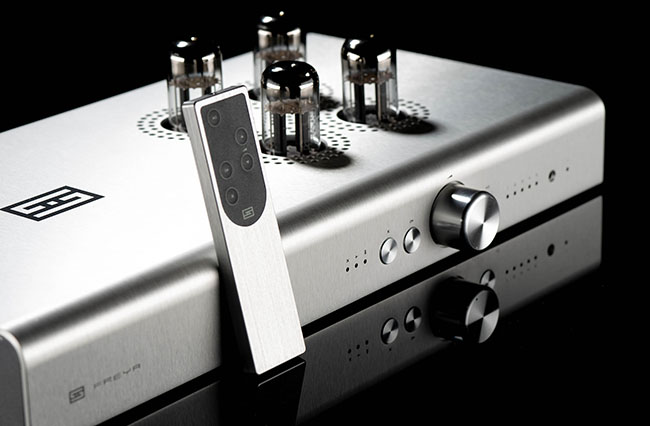
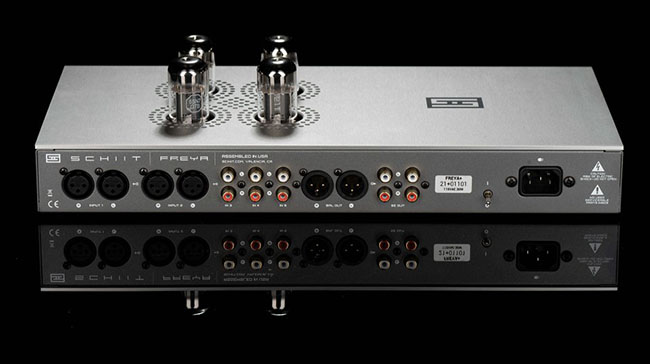
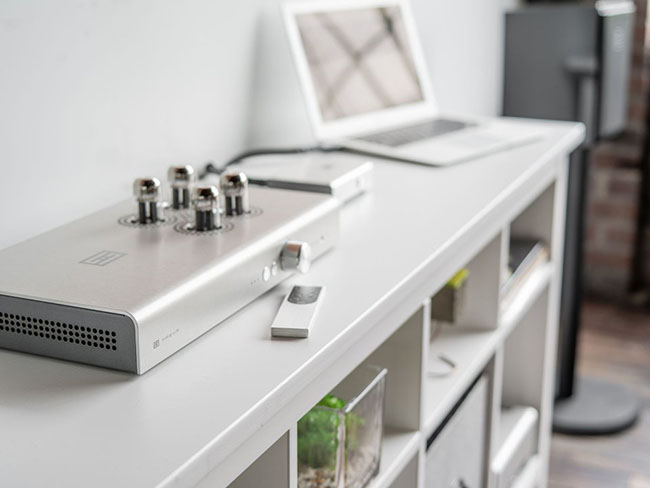


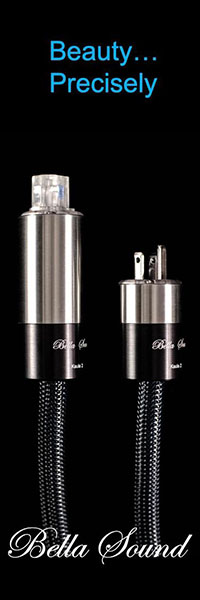


Be the first to comment on: Schiit Audio Freya + Tube Preamplifier by Paul Szabady